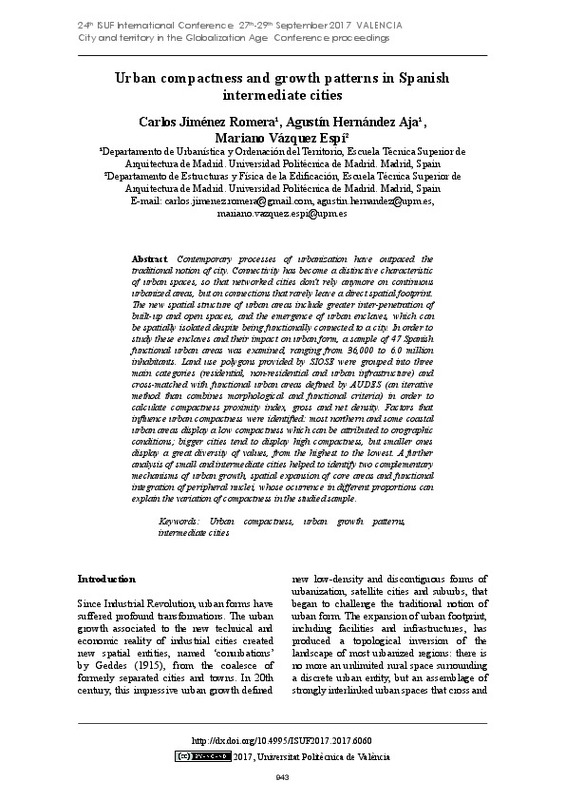JavaScript is disabled for your browser. Some features of this site may not work without it.
Buscar en RiuNet
Listar
Mi cuenta
Estadísticas
Ayuda RiuNet
Admin. UPV
Urban compactness and growth patterns in Spanish intermediate cities
Mostrar el registro sencillo del ítem
Ficheros en el ítem
| dc.contributor.author | Jiménez Romera, Carlos
|
es_ES |
| dc.contributor.author | Hernández Aja, Agustín
|
es_ES |
| dc.contributor.author | Vázquez Espí, Mariano
|
es_ES |
| dc.date.accessioned | 2018-12-28T07:23:37Z | |
| dc.date.available | 2018-12-28T07:23:37Z | |
| dc.date.issued | 2018-04-20 | |
| dc.identifier.isbn | 9788490485743 | |
| dc.identifier.uri | http://hdl.handle.net/10251/114543 | |
| dc.description.abstract | [EN] Contemporary processes of urbanization have outpaced the traditional notion of city. Connectivity has become a distinctive characteristic of urban spaces, so that networked cities don’t rely anymore on continuous urbanized areas, but on connections that rarely leave a direct spatial footprint. The new spatial structure of urban areas include greater inter-penetration of built-up and open spaces, and the emergence of urban enclaves, which can be spatially isolated despite being functionally connected to a city. In order to study these enclaves and their impact on urban form, a sample of 47 Spanish functional urban areas was examined, ranging from 36,000 to 6.0 million inhabitants. Land use polygons provided by SIOSE were grouped into three main categories (residential, non-residential and urban infrastructure) and cross-matched with functional urban areas defined by AUDES (an iterative method than combines morphological and functional criteria) in order to calculate compactness proximity index, gross and net density. Factors that influence urban compactness were identified: most northern and some coastal urban areas display a low compactness which can be attributed to orographic conditions; bigger cities tend to display high compactness, but smaller ones display a great diversity of values, from the highest to the lowest. A further analysis of small and intermediate cities helped to identify two complementary mechanisms of urban growth, spatial expansion of core areas and functional integration of peripheral nuclei, whose ocurrence in different proportions can explain the variation of compactness in the studied sample. | es_ES |
| dc.format.extent | 11 | es_ES |
| dc.language | Inglés | es_ES |
| dc.publisher | Editorial Universitat Politècnica de València | es_ES |
| dc.relation.ispartof | 24th ISUF International Conference. Book of Papers | es_ES |
| dc.rights | Reconocimiento - No comercial - Sin obra derivada (by-nc-nd) | es_ES |
| dc.subject | Urban compactness | es_ES |
| dc.subject | Urban growth patterns | es_ES |
| dc.subject | Intermediate cities | es_ES |
| dc.title | Urban compactness and growth patterns in Spanish intermediate cities | es_ES |
| dc.type | Capítulo de libro | es_ES |
| dc.type | Comunicación en congreso | es_ES |
| dc.identifier.doi | 10.4995/ISUF2017.2017.6060 | |
| dc.rights.accessRights | Abierto | es_ES |
| dc.description.bibliographicCitation | Jiménez Romera, C.; Hernández Aja, A.; Vázquez Espí, M. (2018). Urban compactness and growth patterns in Spanish intermediate cities. En 24th ISUF International Conference. Book of Papers. Editorial Universitat Politècnica de València. 943-953. https://doi.org/10.4995/ISUF2017.2017.6060 | es_ES |
| dc.description.accrualMethod | OCS | es_ES |
| dc.relation.conferencename | 24th ISUF 2017 - City and Territory in the Globalization Age | es_ES |
| dc.relation.conferencedate | Septiembre 27-29,2017 | es_ES |
| dc.relation.conferenceplace | Valencia, Spain | es_ES |
| dc.relation.publisherversion | http://ocs.editorial.upv.es/index.php/ISUF/ISUF2017/paper/view/6060 | es_ES |
| dc.description.upvformatpinicio | 943 | es_ES |
| dc.description.upvformatpfin | 953 | es_ES |
| dc.type.version | info:eu-repo/semantics/publishedVersion | es_ES |
| dc.relation.pasarela | OCS\6060 | es_ES |








